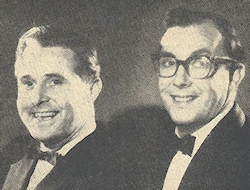Display Shelves For Morecambe and Wise
1960 Article

Those amiable funsters

You too could make this
It promised to be quite a session. Morecambe said: “I want the shelves to display some credit notes I got from my agent. I had them framed..”
Said Wise: “I shall use mine to display my Oscars. They fade so quickly when I hang them in the window…”
Morecambe continued: “Or then again Mr Capper – I could show off my hunting trophies…”
Wise exploded: “Hunting trophies? – what hunting trophies?” he spluttered.
Morecambe smirked: “Are you kidding?” he asked.
I knew I would have to be firm. “Do I gather you want to make some display shelves?” I said.
“Yes, from wood and with a hammer and things.” Was the reply.
I gave up. The next day I sent some advice to the famous comedians, through the post.
Contemporary display shelves need to be simple; the simpler the better. They should house a certain collection of keepsakes, not bits and pieces. The unit shown in the photograph is within the scope of any handyman.
The top and bottom horizontal pieces are of the same length, as are all the verticals. Timber used is 4 by ¾ inch planed deal and butt joints can be used throughout. A back piece of 3-ply or hardboard keep the framing firm and square.
The staggering of the compartments means that no complicated joins are sued; there is space to nail everything together. A refinement is to round all edges on the front. Nail heads should be punched below the surface and the holes filled with wood filler.
The finished unit looks best gloss-painted in white or off-white. It is fixed to the wall with screws, through the back piece and into rawplugged holes. The backs of the compartments should be papered or painted. If papering, use a vivid colour. Incidentally, the paper will conceal the heads of the fixing screws.
If you prefer painting, again use something startling. A modern effect is obtained by painting the back of each compartment a different colour. It will look very old-fashioned if you paint the complete unit in one shade.
Another pleasing effect is shown in the photograph. The compartment backs have been papered with contrasting paper used in the main decoration of the room.
© Hobbies Weekly 1960